Chapter 19. The Journey to Become a Giant
19.1 Introduction

Author: Kristin Miller
Editor: Grace L. Deming, University of Maryland

The goals of this module: After completing this exercise, you should be able to:
- Describe how the location and rate of fusion reactions affect a star's basic properties during each evolutionary stage.
- Explain what the helium flash is and why it occurs.
- Understand how the Sun's future evolution will impact life on Earth.
In this module you will explore:
- How the balance between pressure and gravity in a star's interior changes as the star evolves.
- The difference between a degenerate vs. a nondegenerate gas.
- The different evolutionary paths taken by stars of very low mass (< 0.4 M\(\odot\)), low mass (0.4 to 2-3 M\(\odot\)), and high mass (> 2-3 M\(\odot\))
Why you are doing it: The journey a star undergoes as it transitions from a main sequence star to a horizontal branch star is full of counterintuitive and interesting surprises. As we study this journey, you will gain insight into the basic properties of stars, how these properties change as the star evolves, and how interconnected the interior of a star really is. You will also be given a glimpse into our future - a peek at what will happen to Earth and our Solar System as our Sun ages.
19.2 Background
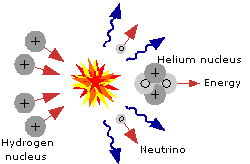
When a star begins hydrogen fusion in its core, it becomes a main-sequence star. By the same token, when the star ceases to burn hydrogen in its core, it can no longer be termed a main-sequence star. So, the question becomes: why does a star stop burning hydrogen in the core?
The process of fusion is self-terminating. The fuel required for fusion - 4 hydrogen nuclei - is consumed by the process, creating a helium nucleus in their place. As fusion continues, more and more of the core's large, but finite, supply of hydrogen is converted into helium; it is only a matter of time until there simply is no fuel left, so core fusion stops. A star like our sun will burn hydrogen in its core for roughly 10 billion years, before ending its main-sequence lifetime with a core that is 99% helium and 1% metals (nuclei heavier than hydrogen or helium). A much higher mass star will last only a few million years before reaching this same evolutionary point and interior composition.
Question 19.1
vCruagH1NUSqxibyzlu/eJinGgd37ohu5CcRtlk6TiXiOqkg7QRD+hku7+2fAncmVwvGhYbdJLoEAfLfguSBQGvCELiWo7m6H5HtpV+Pseafn23pHDo0EPLMgDmZBWIzsgp3gGKaDYePHVhcU/95z0ghohWCRf/VXEa5wcvKLYpyIMR5aCTbPcumoaQ=Summary
A very low mass star takes hundreds of billions of years - more than the current age of the universe - to end its main-sequence life. Because stars less than 0.4 M\(\odot\) are fully convective, all of the hydrogen from the outer layers of these stars will be mixed into the core and converted to helium during their stay on the main-sequence, as shown in the figure to the right. Such low mass stars leave the main-sequence phase with a composition of 99% helium not just in the core, but throughout the entire star. These small stars, now just balls of hot helium gas, do not have enough mass to reach the temperatures and pressures required for helium fusion. Thus, unlike their more massive counterparts, they do not continue to evolve after leaving the main-sequence, but instead end their lives by radiating their energy away quietly - cooling, shrinking, and fading.
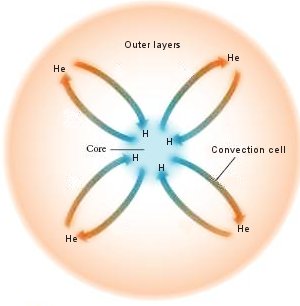
In this activity, we will examine the post main-sequence evolution of stars more massive than 0.4 M\(\odot\), including our sun. We will consider the consequences that the sun's evolution will have for life on Earth.
19.3 Leaving the Main Sequence
When all of the hydrogen in its core has been converted to helium via fusion, a star has lost its main internal energy source. Without a heat source, the core begins to cool, which lowers the pressure there. This means that the core of the star is no longer in hydrostatic equilibrium: there is not enough pressure in the core to support it against gravity, so the core begins to contract. When any object contracts under the influence of gravity, it heats up as gravitational energy is converted into thermal energy, or heat. Thus, the contraction helps to heat the core and also raises the pressure there; however, it is not enough to balance the downward pull of gravity and restore equilibrium. As we will see, the core will continue to contract and equilibrium will not be restored until it reaches the point that helium fusion can begin. The heat produced by contraction is enough to increase the core's temperature; counter intuitively, this means that when the core stops fusing and loses its primary heat source, it actually becomes hotter!!
The following animation illustrates this process. Click on PLAY to begin the contraction.

Question Sequence
Question 19.2
8puh0yVKq5TwXxKyMTOHCr7JKdLPMEz/MC/4UkuxXEXeW8fTt1twii4U/GB9YiqB1cAmBxVTQJxXThzsO5sR+8mMHK3KsRQJEm1LRx1NvTc4OnOcALyqXWhIq30hQIs9TITGg5r6MXfHgwSFQuestion 19.3
vyDiFd1YUZHeJAnf5d3Xbl+5XdYhCGm1erNDjX8AgMbJ8Gbw8MBdJk3wTzxixBsYsnBzkDAn9lqMkEMoGM8Bmdo588e29NgRncgFExfPuAvuYM44u3yGb8jtGRLiW91JQmThhTPJAEcAhDpkaPpdFaqP/eL3cDZVD2YEMRbYhiHqVydUqVum3c/xNYf8qNJ7Cq+neA==Summary
Even before leaving the main-sequence, heat from the core raises the temperature in the surrounding layers enough that hydrogen fusion begins in a shell just outside the core. As the core contracts and heats up more, its energy output increases as well, and the shell of hydrogen fusion thickens, moving outward into the star. The fusion reactions in the shell speed up under the influence of the higher temperatures. The helium produced in the shell rains down onto the core, increasing its weight and thus speeding its contraction. The faster contraction increases the core's temperature more quickly, which in turn increases the heating of the shell and the rate of the fusion reactions there. This cyclic process continues until the core has shrunk significantly (to about one-third of its original size for a solar mass star) and increased its temperature to 100 million K, the temperature at which helium fusion begins.
19.4 The Outer Layers
All of the changes inside the star do not go unnoticed by its outer layers. The high rate of fusion in the hydrogen shell surrounding the core produces large amounts of energy, which radiate out through the star's outer layers. This increase in radiation leads to an increase in the star's luminosity, and the star becomes many times brighter than it was on the Main Sequence - thousands of times brighter for a star like our Sun.
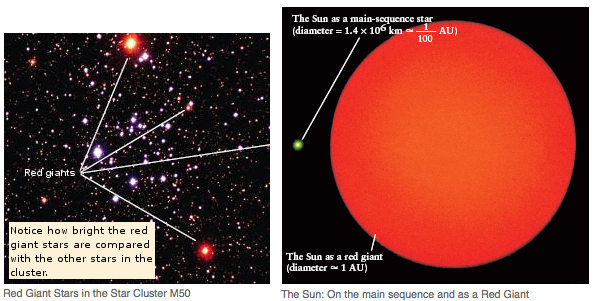
The increase in energy also upsets the balance between pressure and gravity in the star's outer layers, tipping the scales in favor of pressure and causing the star to expand significantly. So, the star is out of balance in both the core and the outer layers, but while gravity wins in the contracting core, pressure wins in the expanding stellar envelope! This expansion is why the next phase of the star's life is known as the red giant phase. A red giant star is many times larger than it was on the Main Sequence. Our Sun, for example, will expand to nearly 100 times its current size - large enough to fill the orbits of Mercury and perhaps, Venus! The red giant sun is compared to the main sequence sun in the figure above.
As the star expands, its outer layers cool, causing the surface temperature to decrease. When the surface temperature drops as low as 3500 K, the star will appear red. At this point, it is truly a red giant! This is shown in the animation below.

Question Sequence
Question 19.4
uQccpeRjS0C5kAswji3B8gTdT4JqVmVjewt4NPVUsImAOXKTGz7q4d2dIysadKTTqf6T6AH6slS9lz+pylT26gTZxJUopHqyw4VwyCbXsz7wkC7OvRlgLiKoVpNAOnndcFyvDyoHw3q85VA8igLNx6ZX5sIO7ilhxDUXDUUhMVFjWM7xXdGtZiE2zvqin/0U0xT90ysaIE/UDLGTRxfv3wtQzVD1zbFqcMq+H5Z9Fl22eesWepDCTcw/qBSVnczcwCBKl5VZ3/9Nzhf0US/lCCuCakyx2yjoQuestion 19.5
v05pme4st8IXTDF3MGSLTm+TCK1Kb15yEvGBsANGhkbAm2TdVlfgkkiIRq1pKXHEW3B58u7r+5pV4EjzdM0VGo2KveKRkWTlNSUFlqUdR+jQsnOxIuugRSdHaGfBL93ZQPtkIejHMb9Nk3oWnfi9E/PqrE8tBK651dufReCBi3eLCzESkGYTsziHLB0HYBYo+RIYZcO5NeCnhLmDC4r2dJ2BWw5DAAmJXo4AEIx1IWq/g+Yy/z+f3SADGRcw8JtSOGNOsuT2yjdUPvXq2iyzI+UNQSNwkcDrRtINqUa1LKmfKC69qpkO0H9iWGbQYB11Fx/WdPwLQZtY2B5NW0gl9YzzG2c=Question 19.6
KB2/9maQdQFZhJ7831cOWYlm1ibm/lQL8pNdb2c8gDgrQkPpMdouVRVBGbDo0mAJPemz8CIqh94YgDPijxOgab3d/eI+xyNzpn0AYkH4LzrQiEjiFsw+mXs9z9NsTJwqJPnl00MJepy/uyaPcwZHVS8fnxE=Summary
The expansion of the star's outer layers also means that its surface gravity decreases (remember that surface gravity decreases when the radius of the object increases). Stellar gases at the surface can more easily escape from this weaker surface gravity, causing the red giant star to lose mass at a much higher rate than it did on the main sequence. Red giants lose twice as much (or sometimes even more) material per year than their main sequence counterparts!
19.5 Helium Fusion Begins!
As the temperature of the contracting core increases, the central core temperature eventually reaches 100 million K, and helium fusion begins. Finally, the star has a central energy source again! For stars with masses larger than about 2-3 solar masses, helium fusion begins quietly and gradually, starting first at the very center and then moving outward as more of the core attains the needed temperature.
The situation is dramatically different for stars with lower mass (0.4 M\(\odot\) to 2-3 M\(\odot\)). In these stars, the core contracts to a state of very high density before it reaches the temperature needed for helium fusion to begin. In fact, the density becomes so high that individual electrons are pushed as close together as they can possibly be, according to the rules of quantum physics. In these close quarters, they exert an enormous pressure that prevents the core from contracting further. In this state, the core of the star is termed degenerate, and the pressure exerted by the electrons is known accordingly as electron degeneracy pressure. One of the peculiar characteristics of a degenerate gas is that, unlike in a normal (non-degenerate) gas, a degenerate gas does not expand or contract as its temperature changes. This important difference between normal and degenerate gases is shown in the animation below. Change the temperature by moving the slider up or down.

Question Sequence
Question 19.7
o3AQD8gVRUuB+MJ0Hvscjbp3JvPsGq+tCXxeVzQS8+lk1Hf/AOCLjXxA50LLaAY9kEhLS35AJGnBQVZrolXvELea34CnX2oAgGbFRmdh2tIsEwzHifQNKZnavjJ7QgJPPNGtq0K4j2Vjcv0OpQkyu1tj3EIriweTBRO9aSx2rkmJXWTR+j1Vgu7s+AbcmAvbPVSHS/eiOzH96d6zrgfx7mzE9Oay0+Qs8jF1D5RQtd5JF5mimgqgjl8bNnWn8sOooifTU4ngckfcnt6XBgm1L7VJgaZuVhT3nTTvi1ji9IgwpMFZZMuGZ4PaOM4Kx/cAiPNYIPt8IXEgsKDmCkrCQjb1Rb0Nb2nxQuestion 19.8
MsTDXugmo+KkwEOrFHNVb080XBzbZrgP80Hqnb/iKtCAPgqnZZAdtkWPwH4DttcnjoEoWehw+w6Od73C0BhZaj/QVUr8n8XApKzY6Ebu+4WNC2ubpF6GYPjFnZ0n5EDXsGkGC9WwTuUY+TwcmMjLO5hLVBCSCXrQWDA8GCVUsqrx9nogtuB/0KWL4jdbKZciGdSEjA==Summary
This peculiar property of degenerate gases means that when fusion begins in the degenerate core, a run away cycle begins in which the energy produced by fusion raises the core's temperature. The higher temperature causes the fusion reactions to occur more rapidly and produce more energy, which raises the temperature even higher (and so on). Because the core cannot expand and cool to regulate the fusion process, helium burning proceeds wildly and unchecked, producing copious amounts of energy. This period of uncontrolled burning is known as the helium flash. It lasts only very briefly on the stellar timescale, but during that time the energy produced is billions of times more than what was produced by the star while on the main sequence!
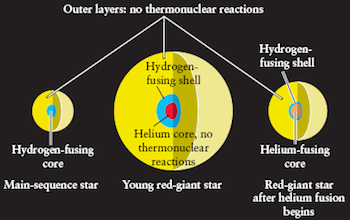
The helium flash ends when the core temperature rises high enough that the electrons become non-degenerate. The gas then expands and cools, the fusion reactions slow, and helium burning proceeds stably, as in higher mass stars.
The changes the interior of the star has undergone since leaving the main sequence are shown in the figure.
19.6 The Horizontal Branch

Once helium fusion begins in the core, the star enters a stable period of evolution somewhat reminiscent of the main-sequence stage. The new core energy source provides the pressure needed to balance gravity, and the contraction stops. As fusion heats the core, it expands and cools. In turn, the temperature in the layers just outside the core also decreases, which slows the rate of fusion in the hydrogen shell. This causes the outer layers of the star to contract (and thus heat up). Overall, balance is now restored throughout the star, but it is a different balance from the one the star enjoyed on the main sequence. Compared to its original values on the main sequence, the luminosity of the horizontal branch star is higher (although it is lower than it was during the red giant phase due to the decrease in energy output from the hydrogen shell). The star's surface temperature is also lower compared to its main sequence value. Its radius, though smaller than in the red giant phase, is larger then it was on the main sequence, because its outer layers are now supported by both a core and a shell energy source.
Question 19.9
EDuAGc9bOUpnk5M23JrX7acxa/Rbgh5Y5sWNRKX1AKS6J+WdSlvk00A1dyF1pMn6ADpi70x7dwR+7K8YtuntGiJAMECaJp3KEZYMoVC2fuj9iOwrCZgL72jBR5eF2LCx2hFkZ8C8k9y9QEM+xkrNulL5GylAXpwR09AQdWw6SumrQ80kcruDYd1Lo5b/Bt1Uo5KK18xsVvY1NYLGReKXDERXdsf41VQGKWZYXhmsJmxVzVEaF0MK3dFG8ckPgyhTdyLHwS1RUzn8C4R4Zcy/PcriIgDbBn+fVGBeO9vkVxUaAcfUT4fCnfMzHDVLCpxPnu37ODSgpVo0pSP/Zc9tlCk6/PH5DpFHsHGpC3eaUUZKx3kNQGDwkD6+MYdza1adgS9LIfsRravAwowBUw/fgdXo7Ep3JSsgSummary
The star's sojourn on the horizontal branch is much shorter than its main-sequence lifetime. For a star like the Sun, it lasts only 100 million years - less than 1% of the Sun's main-sequence lifetime. The changes high and low mass stars undergo as they move from the main sequence to the horizontal branch are summarized in the H-R diagram below. Compare the differences that are mass driven.
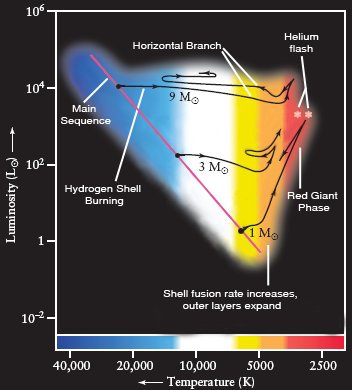
19.7 What About Us?!
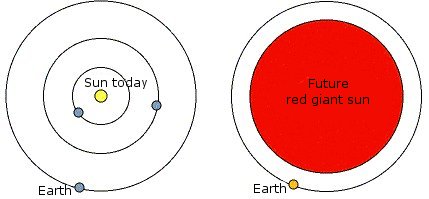
In this activity, we have seen that our Sun is destined to undergo major changes in size, luminosity, and temperature when it ends its main-sequence lifetime. But what will these changes mean for human beings and all life on Earth? As it turns out, the answer to that question is grim...
The Sun's luminosity is actually gradually increasing during its main-sequence life. The changes are quite small on a human timescale, but on a planetary timescale, they add up to a significant amount. In a mere one and a half billion years from now, the average surface temperature on Earth will be 122°F, about twice as hot as it is today. Two billion years later, the average surface temperature on Earth will exceed the boiling point of water. This means that all liquid water on Earth will boil away, and the Earth will become a dry, barren planet - incapable of supporting life as we know it. All of this will happen before the Sun even leaves the main sequence! And then gets even worse!
When hydrogen fusion ceases in the Sun's core, its outer layers will begin to expand, consuming first the planet Mercury, then it nears Venus, reaching a diameter of at least 1 AU - about 100 times as large as it is now. Its luminosity will be 2000 times the present value! At this point, some of the inner planets will likely be vaporized and the thick atmosphere of the giant outer planets will evaporate, exposing their rocky cores. It is unlikely that life of any kind will survive on Earth to witness the Sun's further evolution onto the horizontal branch, as depicted in the video below. Watch video.

Question 19.10
wysEwkLY4gAeIG1YFnTb0ZrqdKAqLyJGECuMhVqeVoHiJjwbmCUdFrQEXQ5kBmIwz6mmWqlNsjOEP01Z6D+1QPEXzUUSCIPgDlnM5EKf5H8MiPk99HAJuLvDLKL5Y86InM5Z+jCI/fwYDgxYiJBgraOSB6w27RF5UeqpLJcaepcShapmV6z/9kZ1l9sn016/Summary
In this tutorial, you have learned about the many changes that occur within a star as it struggles to regain equilibrium during its post main-sequence lifetime. These internal changes affect every part of the star and cause big differences in important stellar properties like luminosity, size, and temperature. You have also seen how these changes will affect planets (like ours!) when their parent stars evolve. Hopefully you have caught a glimpse of how interesting and exciting studying the lives of stars can be!
19.8 Quick Check Quiz
Indepth Activity: The Journey to Become a Giant